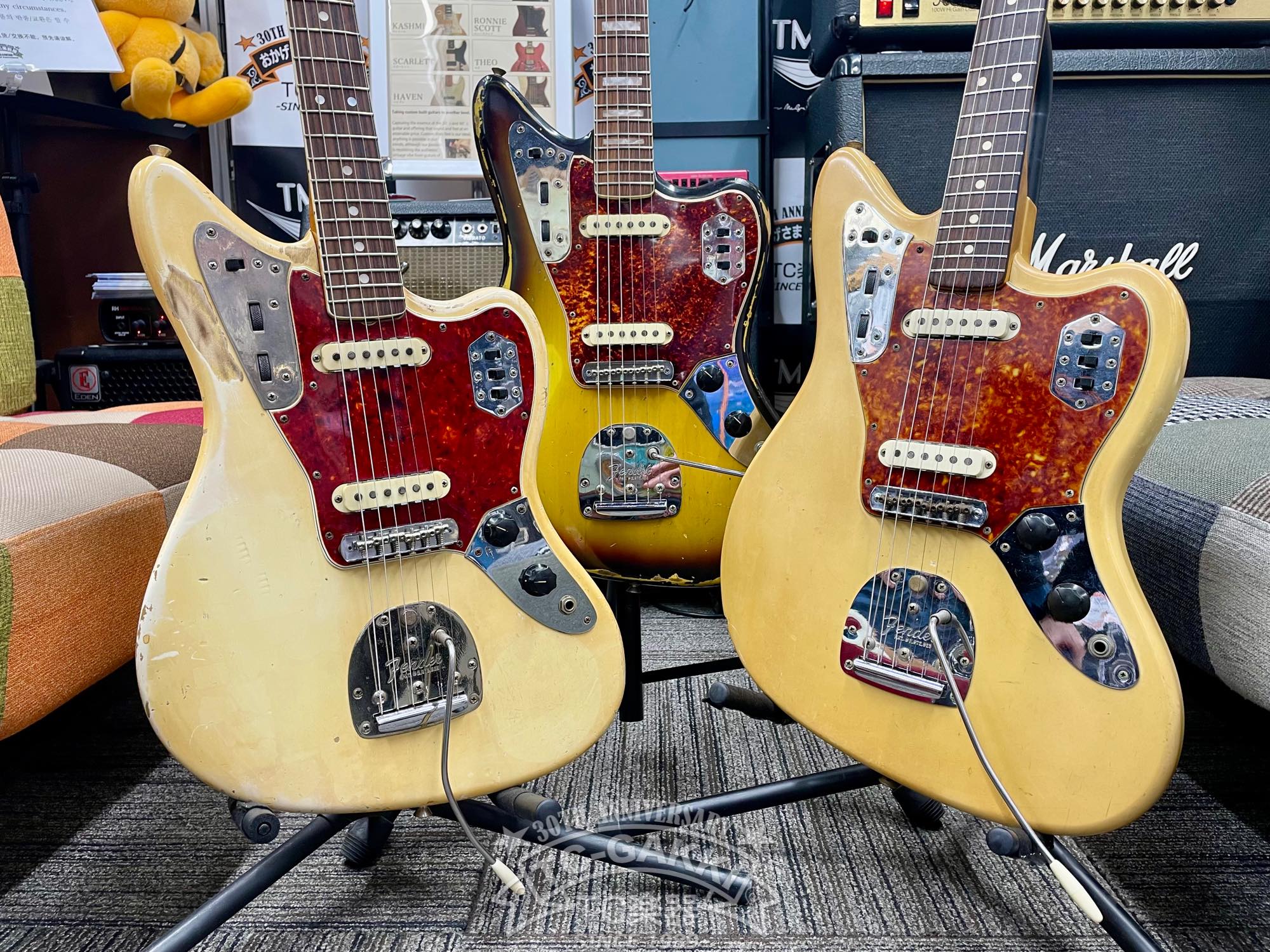Electric GuitarOdaI am
I am pleased to announce the vintageFender JaguarWe are pleased to announce that we have just received several vintage Fender Jaguars!
And they are from the same period of 1965~6.but with different specs!were miraculously aligned.
Since they are rare and valuable vintage pieces, and since there are not so many opportunities to compare them like this, we would like to introduce them by comparing them.
First of allHistory of Fender JaguarWe will start with the history of the birth of Fender Jaguar.
In the 1950s, Fender introduced the Telecaster and then the Stratocaster. With these two models, Fender gained status and fame as an upstart instrument maker, and developed new products to break into the jazz field, which was dominated by Gibson and Epiphone at the time.
In 1958, Fender introduced the "Fender Jazz Guitar", which, as the name implies, was aimed at jazz guitarists.JazzmasterJazzmaster. Although it did not succeed in capturing the conservative jazz guitarist demographic, it spread around the world with the surf music boom in the early 60's and became Fender's most popular model at the time.
Following the success of the Jazzmaster, Fender developed theJaguarJaguar was developed based on the success of the Jazzmaster.
Jaguar is a guitar that has been used by surf music guitarists who used to play Jazzmaster.The neck scale is too long," and "I want a brighter sound.The Jaguar was developed in response to the requests of surf music guitarists who used the Jazzmaster.
The Jazzmaster's specifications are inherited from the Jazzmaster, including the offset contoured body and floating tremolo unit.
The scale was changed from the 25 1/2" of the Stratocaster and Jazzmaster to24 in.to 24". Also, the scale was changed from 25 1/2" to 24" for the Stratocaster and Jazzmaster,Yoke (metal cover) on PUThe PU selector has been changed to aon/off and low-cut switch for each PU.The PU selector is used to turn each PU on and off and to select a low-cut switch.
In the late 1960s, hard rock became popular worldwide, and Jaguar's short sustain made it unsuitable for high-gain distorted guitar solos, etc. Sales gradually declined, and production was discontinued in 1975.
In the 1990s, the Jaguar came back into the limelight when Kurt Cobain of Nirvana and John Frusciante of the Red Hot Chili Peppers used it, and even though it was discontinued once, it still boasts strong popularity.
Despite its discontinuation, it is still very popular today.JaguarWe are pleased to introduce several Jaguar models from the 60's, the heyday of the Jaguar brand!
1960s Fender JAGUAR Blonde
This is a very rare Blonde Finish 1960s Jaguar with Ash body.
This is the last model before the binding was added to the side of the fingerboard.
The logo has been redecaled, but the pickups are Black Bobbin and the pots are from 1962.
1966 Fender JAGUAR Olympic White
This guitar has binding on the side of the fretboard, and the position mark is a dot.
The pegs, bridge, and front preset tone condenser have been replaced, but the bind dot period is very short from the end of 1965 to the middle of 1966.
1966 Fender JAGUAR 3 Tone Sunburst
This guitar was changed to block position mark in the middle of 1966, and was manufactured with the same specification until 1974.
This is an example from right after the specification change, and it has the characteristic of sunburst with faded reddish color from the mid-1960s.
Fender had been acquired by CBS between 1965 and 1966, and changed the specifications of various models.
JaguarJaguar is no exception.
Now, let's take a look at this miraculously aligned Jaguar, comparing it part by part!
[Bindings/Position marks

[60s BlondeAsh]
Dot position without binding (last period before specification change)

['66OlympicWhite]
Individuals from the end of '65 to the middle of '66, the period known as the "bound dot" period.

['66 3TS].
The mark was changed to a block position mark in the middle of 1966, and this specification was used until 1974, when production was discontinued.
Neck plate]

[60s BlondeAsh]
5 digit serial number engraved, no F engraved.
['66OlympicWhite]
Six-digit serial number stamped with F.
['66 3TS]
Also 6 digit serial number with F stamped on it.
[pegs].


[60s BlondeAsh]
It is hard to tell by the rust, but these are single line Cruson pegs that were used until 1963.

['66 3TS]
F key 1stver. These pegs were used from mid-66 to 71.
Pickguard]

['60s BlondeAsh]
Tortoiseshell/white/black/white
4-ply celluloid

['66OlympicWhite].
Tortoiseshell/white/black/white
4-ply, only black is celluloid, other layers are vinyl chloride

['66 3TS].
Tortoiseshell/white/black/white
4-ply, only black is celluloid, other layers are vinyl chloride
Hard case



[60s BlondeAsh]
Brown Tolex case used from around 1962.
2nd version, as the center hardware is outside the handle.
The interior lining is a slightly reddish orange color.



['66 OlympicWhite]
Black tolex case with Fender logo.
Changed to black torex around 1964.
How was it?
It is only in 1965~6 that there is such a big difference in the production period of about one year.
Which Jaguar is your favorite?
Oda.




